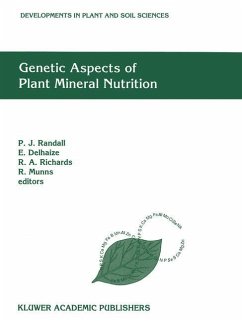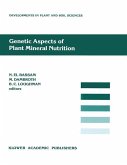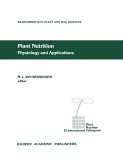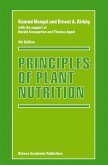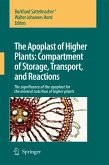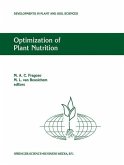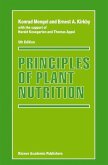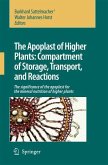Genetic Aspects of Plant Mineral Nutrition
The Fourth International Symposium on Genetic Aspects of Plant Mineral Nutrition, 30 September ¿ 4 October 1991, Canberra, Australia
Ed. by Randall, P.J.; Delhaize, E.; Richards, R.A.; Munns, Rana
Genetic Aspects of Plant Mineral Nutrition
The Fourth International Symposium on Genetic Aspects of Plant Mineral Nutrition, 30 September ¿ 4 October 1991, Canberra, Australia
Ed. by Randall, P.J.; Delhaize, E.; Richards, R.A.; Munns, Rana
- Broschiertes Buch
- Merkliste
- Auf die Merkliste
- Bewerten Bewerten
- Teilen
- Produkt teilen
- Produkterinnerung
- Produkterinnerung
The adaptation of desirable agricultural plants to infertile and problem soils is an increasingly important trategy for improving food supplies in many parts of the world. The plant breeding approach complements, and in some cases may replace agronomic practices such as the use of fertilizers and soil amendments to provide solutions which are economically and environmentally sustainable. The Symposium at which the papers in this volume were presented drew together workers in plant breeding, plant nutrition, physiology, biochemistry and molecular biology to discuss research on gene systems…mehr
Andere Kunden interessierten sich auch für
![Genetic Aspects of Plant Mineral Nutrition Genetic Aspects of Plant Mineral Nutrition]() Nasir El BassamGenetic Aspects of Plant Mineral Nutrition229,99 €
Nasir El BassamGenetic Aspects of Plant Mineral Nutrition229,99 €![Plant Nutrition - Physiology and Applications Plant Nutrition - Physiology and Applications]() M.L. Van Beusichem (ed.)Plant Nutrition - Physiology and Applications139,99 €
M.L. Van Beusichem (ed.)Plant Nutrition - Physiology and Applications139,99 €![Principles of Plant Nutrition Principles of Plant Nutrition]() Konrad MengelPrinciples of Plant Nutrition344,99 €
Konrad MengelPrinciples of Plant Nutrition344,99 €![The Apoplast of Higher Plants: Compartment of Storage, Transport and Reactions The Apoplast of Higher Plants: Compartment of Storage, Transport and Reactions]() Burkhard Sattelmacher / Walter J. Horst (eds.)The Apoplast of Higher Plants: Compartment of Storage, Transport and Reactions149,99 €
Burkhard Sattelmacher / Walter J. Horst (eds.)The Apoplast of Higher Plants: Compartment of Storage, Transport and Reactions149,99 €![Optimization of Plant Nutrition Optimization of Plant Nutrition]() Optimization of Plant Nutrition383,99 €
Optimization of Plant Nutrition383,99 €![Principles of Plant Nutrition Principles of Plant Nutrition]() Konrad MengelPrinciples of Plant Nutrition307,99 €
Konrad MengelPrinciples of Plant Nutrition307,99 €![The Apoplast of Higher Plants: Compartment of Storage, Transport and Reactions The Apoplast of Higher Plants: Compartment of Storage, Transport and Reactions]() The Apoplast of Higher Plants: Compartment of Storage, Transport and Reactions149,99 €
The Apoplast of Higher Plants: Compartment of Storage, Transport and Reactions149,99 €-
-
-
The adaptation of desirable agricultural plants to infertile and problem soils is an increasingly important trategy for improving food supplies in many parts of the world. The plant breeding approach complements, and in some cases may replace agronomic practices such as the use of fertilizers and soil amendments to provide solutions which are economically and environmentally sustainable. The Symposium at which the papers in this volume were presented drew together workers in plant breeding, plant nutrition, physiology, biochemistry and molecular biology to discuss research on gene systems which affect the mineral nutrition of plants. Papers describe successes in plant breeding for problem soils as well as advances in understanding of mechanisms at the whole plant and cellular levels. Papers in the 'molecular' area point the way to the contribution which the new biology will make to this field in the future. The reviews and research papers are grouped under five topics : Better plants for acid soils; Salinity tolerance; Efficiency of uptake and use of macronutrients; Efficiency for iron and micronutrients; Tolerance of heavy metals and boron.
Produktdetails
- Produktdetails
- Developments in Plant and Soil Sciences .50
- Verlag: Springer / Springer Netherlands
- Artikelnr. des Verlages: 978-94-010-4721-0
- Softcover reprint of the original 1st ed. 1993
- Seitenzahl: 432
- Erscheinungstermin: 26. Oktober 2012
- Englisch
- Abmessung: 260mm x 195mm x 24mm
- Gewicht: 906g
- ISBN-13: 9789401047210
- ISBN-10: 9401047219
- Artikelnr.: 37477674
- Herstellerkennzeichnung
- Springer-Verlag GmbH
- Tiergartenstr. 17
- 69121 Heidelberg
- ProductSafety@springernature.com
- Developments in Plant and Soil Sciences .50
- Verlag: Springer / Springer Netherlands
- Artikelnr. des Verlages: 978-94-010-4721-0
- Softcover reprint of the original 1st ed. 1993
- Seitenzahl: 432
- Erscheinungstermin: 26. Oktober 2012
- Englisch
- Abmessung: 260mm x 195mm x 24mm
- Gewicht: 906g
- ISBN-13: 9789401047210
- ISBN-10: 9401047219
- Artikelnr.: 37477674
- Herstellerkennzeichnung
- Springer-Verlag GmbH
- Tiergartenstr. 17
- 69121 Heidelberg
- ProductSafety@springernature.com
Are we justified in breeding wheat for tolerance to acid soils in southern New South Wales?.- Comparison of techniques for determining the effect of aluminium on the growth of, and the inheritance of aluminium tolerance in wheat.- Breeding the perennial pasture grass Phalaris aquatica for acid soils.- Screening perennial rye-grass from New Zealand for aluminium tolerance.- Somaclonal variation in plant adaptation to acid soil in the tropical forage legume Stylosanthes guianensis.- Tolerance to manganese toxicity among cultivars of lucerne (Medicago sativa L.).- Response to soil aluminium of two white clover (Trifolium repens L.) genotypes.- Differences in calcium efficiency between cowpea (Vigna unguiculata (L.) Walp.) cultivars.- Wheat growth responses of cultivars to H+ concentration.- Effect of aluminium on the growth of 34 plant species: A summary of results obtained in low ionic strength solution culture.- Callose formation as parameter for assessing genotypical plant tolerance of aluminium and manganese.- Interspecific differences in aluminium tolerance in relation to root cation-exchange capacity.- Preliminary results from a microscopic examination on the effects of aluminium on the root tips of wheat.- Aluminium toxicity: Towards an understanding of how plant roots react to the physical environment.- Increasing salinity tolerance of grain crops: Is it worthwhile?.- Arguments for the use of physiological criteria for improving the salt tolerance in crops.- Why does in vitro cell selection not improve the salt tolerance of plants?.- Variation and inheritance of sodium transport in rice.- Genetics and physiology of enhanced K/Na discrimination.- Association between genes controlling flowering time and shoot sodium accumulation in the Triticeae.- The inheritance ofsalt exclusion in woody perennial fruit species.- Variation in growth and ion accumulation between two selected populations of Trifolium repens L. differing in salt tolerance.- The role of ion channels in plant nutrition and prospects for their genetic manipulation.- Effect of salt stress on plant gene expression: A review.- Protein synthesis in halophytes: The influence of potassium, sodium and magnesium in vitro.- Nutrient efficiency - what do we really mean?.- A review of phosphorus efficiency in wheat.- The involvement of mycorrhizas in assessment of genetically dependent efficiency of nutrient uptake and use.- Screening maize inbred lines for tolerance to low-P stress condition.- Inheritance studies of low-phosphorus tolerance in maize (Zea mays L.), grown in a sand-alumina culture medium.- Inheritance of phosphorus response in white clover (Trifolium repens L.).- Heritability of, and relationships between phosphorus and nitrogen concentration in shoot, stolon and root of white clover (Trifolium repens L.).- Polymorphism and physiology of arsenate tolerance in Holcus lanatus L. from an uncontaminated site.- The role of piscidic acid secreted by pigeonpea roots grown in an Alfison with low-P fertility.- Effect of mineral nutrients and combined nitrogen on the growth and nitrogen fixation of Azolla-Anabaena symbiosis.- Can maize cultivars with low mineral nutrient concentrations in the grains help to reduce the need for fertilizers in third world countries?.- A physiological basis for genetic improvement to nitrogen harvest index in wheat.- Post-transcriptional control of the expression of a plant gene by an environmental factor: Sulphur regulation of the expression of the Pea Albumin 1 gene.- Strategies in population development for the improvement of Feefficiency in soybean.- Genetics of tolerance to iron chlorosis in rice.- Genotypic variation among Indian graminaceous species with respect to phytosiderophore secretion.- Requirement and response of crop cultivars to micronutrients in India - a review.- Selecting zinc-efficient cereal genotypes for soils of low zinc status.- Combining ability of the response to boron deficiency in wheat.- Yield evaluation of a gene for boron tolerance using backcross-derived linesd.- Physiological and genetic control of the tolerance of wheat to high concentrations of boron and implications for plant breeding.- Genetic variation in the response of pea (Pisum sativum L.) to high soil concentrations of boron.- Heavy-metal (Zn, Cd) tolerance in selected clones of duck weed (Lemna minor).- Biosynthesis and metabolic roles of cadystins (?-EC)nG and their precursors in Datura innoxia.- Genes with similarity to metallothionein genes and copper, zinc ligands in Pisum sativum L..
Are we justified in breeding wheat for tolerance to acid soils in southern New South Wales?.- Comparison of techniques for determining the effect of aluminium on the growth of, and the inheritance of aluminium tolerance in wheat.- Breeding the perennial pasture grass Phalaris aquatica for acid soils.- Screening perennial rye-grass from New Zealand for aluminium tolerance.- Somaclonal variation in plant adaptation to acid soil in the tropical forage legume Stylosanthes guianensis.- Tolerance to manganese toxicity among cultivars of lucerne (Medicago sativa L.).- Response to soil aluminium of two white clover (Trifolium repens L.) genotypes.- Differences in calcium efficiency between cowpea (Vigna unguiculata (L.) Walp.) cultivars.- Wheat growth responses of cultivars to H+ concentration.- Effect of aluminium on the growth of 34 plant species: A summary of results obtained in low ionic strength solution culture.- Callose formation as parameter for assessing genotypical plant tolerance of aluminium and manganese.- Interspecific differences in aluminium tolerance in relation to root cation-exchange capacity.- Preliminary results from a microscopic examination on the effects of aluminium on the root tips of wheat.- Aluminium toxicity: Towards an understanding of how plant roots react to the physical environment.- Increasing salinity tolerance of grain crops: Is it worthwhile?.- Arguments for the use of physiological criteria for improving the salt tolerance in crops.- Why does in vitro cell selection not improve the salt tolerance of plants?.- Variation and inheritance of sodium transport in rice.- Genetics and physiology of enhanced K/Na discrimination.- Association between genes controlling flowering time and shoot sodium accumulation in the Triticeae.- The inheritance ofsalt exclusion in woody perennial fruit species.- Variation in growth and ion accumulation between two selected populations of Trifolium repens L. differing in salt tolerance.- The role of ion channels in plant nutrition and prospects for their genetic manipulation.- Effect of salt stress on plant gene expression: A review.- Protein synthesis in halophytes: The influence of potassium, sodium and magnesium in vitro.- Nutrient efficiency - what do we really mean?.- A review of phosphorus efficiency in wheat.- The involvement of mycorrhizas in assessment of genetically dependent efficiency of nutrient uptake and use.- Screening maize inbred lines for tolerance to low-P stress condition.- Inheritance studies of low-phosphorus tolerance in maize (Zea mays L.), grown in a sand-alumina culture medium.- Inheritance of phosphorus response in white clover (Trifolium repens L.).- Heritability of, and relationships between phosphorus and nitrogen concentration in shoot, stolon and root of white clover (Trifolium repens L.).- Polymorphism and physiology of arsenate tolerance in Holcus lanatus L. from an uncontaminated site.- The role of piscidic acid secreted by pigeonpea roots grown in an Alfison with low-P fertility.- Effect of mineral nutrients and combined nitrogen on the growth and nitrogen fixation of Azolla-Anabaena symbiosis.- Can maize cultivars with low mineral nutrient concentrations in the grains help to reduce the need for fertilizers in third world countries?.- A physiological basis for genetic improvement to nitrogen harvest index in wheat.- Post-transcriptional control of the expression of a plant gene by an environmental factor: Sulphur regulation of the expression of the Pea Albumin 1 gene.- Strategies in population development for the improvement of Feefficiency in soybean.- Genetics of tolerance to iron chlorosis in rice.- Genotypic variation among Indian graminaceous species with respect to phytosiderophore secretion.- Requirement and response of crop cultivars to micronutrients in India - a review.- Selecting zinc-efficient cereal genotypes for soils of low zinc status.- Combining ability of the response to boron deficiency in wheat.- Yield evaluation of a gene for boron tolerance using backcross-derived linesd.- Physiological and genetic control of the tolerance of wheat to high concentrations of boron and implications for plant breeding.- Genetic variation in the response of pea (Pisum sativum L.) to high soil concentrations of boron.- Heavy-metal (Zn, Cd) tolerance in selected clones of duck weed (Lemna minor).- Biosynthesis and metabolic roles of cadystins (?-EC)nG and their precursors in Datura innoxia.- Genes with similarity to metallothionein genes and copper, zinc ligands in Pisum sativum L..

